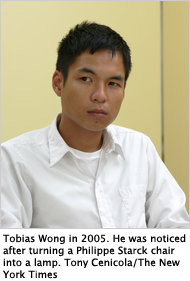Tobias Wong, Witty Designer and Conceptual Artist, Dies at 35
by William Grimes
June 2, 2010
 Tobias Wong, a designer whose outrageous sendups of luxury goods and witty expropriation of work by other designers blurred the line between conceptual art and design, died on Sunday at his home in Manhattan. He was 35.
Tobias Wong, a designer whose outrageous sendups of luxury goods and witty expropriation of work by other designers blurred the line between conceptual art and design, died on Sunday at his home in Manhattan. He was 35.
The office of the chief medical examiner in Manhattan ruled the death a suicide.
Mr. Wong first came to the attention of the design press in 2001 when he turned a Philippe Starck Bubble Club chair into a lamp, softly glowing from within. Adding spice to the stunt, “This Is a Lamp” was shown the night before the actual Starck chair was presented to the public for the first time.
A provocateur by nature, Mr. Wong operated at the fringes of the traditional design world, creating objects like a stack of 100 $1 bills, bound in peelable glue like a notepad; a gold-plated McDonalds coffee stirrer (a riff on the company”™s plastic version that was apparently popular among drug users before being withdrawn); and an engagement ring with the diamond mounted upside down, so that the wearer could use it to scratch graffiti.
“As time went on his work became more and more ironic, sarcastic and pointed,” said Paola Antonelli, senior curator in the Museum of Modern Art”™s Department of Architecture and Design. “He had an enfant terrible style of design that was very fresh in New York. Today you see all sorts of people doing conceptual design, but he was one of the first.”
Ms. Antonelli included two of Mr. Wong”™s works, a rose brooch and a duvet made of bulletproof black Kevlar, in the 2005 exhibition “SAFE: Design Takes on Risk.”
Donald Tobias Wong, known as Tobi, was born in Vancouver, British Columbia, on June 10, 1974. After attending the University of Toronto he studied art and architecture at Cooper Union in Manhattan, eventually concentrating on sculpture. He earned a certificate in art in 2000.
He is survived by his mother, his stepfather, a brother and his partner, Tim Dubitsky.
Early on, Mr. Wong showed a talent for grabbing attention, not all of it approving. The designer Issey Miyake issued a cease and desist order when Mr. Wong used his Pleats Please dresses to make computer screen covers. McDonald”™s also called a halt to the gold-plated coffee stirrers, part of a series, Indulgence, that included a gold-plated Bic pen cap and a gold-plated Playboy swizzle stick.
The designer Karim Rashid was not amused when his book, “I Want to Change the World” was cut by Mr. Wong into the shape of a gun and presented as a critique of designers”™ pretensions and a comment on the post-9/11 world.
“When I do pull a prank, it”™s my means of sending out a conceptual idea,” Mr. Wong said in his defense. “It”™s not just laughing at them.”
Mr. Wong did some of his most arresting work as a kind of curator. For the Terminal 5 show at Kennedy International Airport in 2004, he created a gift shop displaying the work of 18 artists. The objects for sale included cashmere sleep masks and designer air-sickness bags.
One of his most elaborate productions was the Wrong Store, a hoax-like exhibition he organized in 2007 with Gregory Krum, the director of retail at the Cooper-Hewitt, National Design Museum.
The store, in a tiny Chelsea gallery, was stocked with objects by artists and designers from the United States and Europe and appeared, from the outside, to be a bona fide business enterprise. Mr. Wong had a business phone installed and printed letterhead paper and cards for a nonexistent group of directors.
All was not as it seemed, as the discerning might have gathered from a sign in the window that read, “Come In, We”™re Closed.” In fact, the store had never opened.
“He used the term para-conceptual to describe his work, but in a way, I think he was para-design, making jokes about design history, designers”™ pretensions and form and process,” said Ellen Lupton, the curator of contemporary design at Cooper-Hewitt.
On occasion, Mr. Wong ventured into the world of commercial design. His remote-controlled light switch, housed in a Lucite box, sold through design stores, and he designed a matchbook for Alessi with the matches outlining the Manhattan skyline and two white-tipped matches standing in for the twin towers of the World Trade Center. For the most part, however, he preferred Dadaist think pieces to traditional design objects.
“I don”™t draft or create models/prototypes, I don”™t problem solve and I definitely don”™t make things to make life easier,” he told Theme, a design magazine, in 2008.
